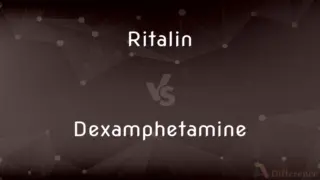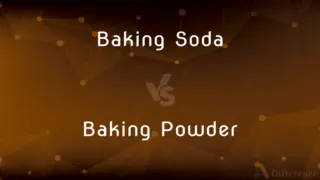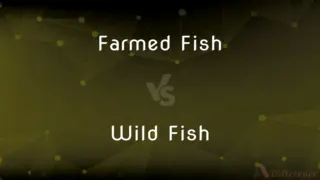Vernalization vs. Stratification — What's the Difference?
Edited by Tayyaba Rehman — By Fiza Rafique — Published on December 17, 2024
Vernalization involves cold treating seeds or plants to induce flowering, while stratification simulates winter conditions to break seed dormancy, promoting germination.

Difference Between Vernalization and Stratification
Table of Contents
ADVERTISEMENT
Key Differences
Vernalization is a process required by some plants to initiate or accelerate flowering, often necessitated by exposure to prolonged cold temperatures. This cold treatment is crucial for certain species to ensure they flower and reproduce at the appropriate time of year. On the other hand, stratification is a technique used to mimic the natural cold period that some seeds must undergo before germination can occur. It is often employed by gardeners and horticulturists to improve germination rates in species with high dormancy levels.
While vernalization is mainly concerned with the flowering process and is typically associated with the growth cycle of biennial and perennial plants, stratification focuses on the early stages of a plant's life cycle, specifically seed germination. Vernalization affects the plant's reproductive development, whereas stratification impacts the initial germination process.
The vernalization process can vary in length depending on the plant species and the required cold exposure, ranging from a few weeks to several months. This period is crucial for the biochemical processes that lead to flowering. Conversely, stratification periods can also vary, with some seeds requiring only a few weeks of cold treatment, while others may need several months to overcome dormancy and trigger germination.
Vernalization is critical for agricultural practices, especially in regions with distinct seasons, as it helps in planning and optimizing crop production cycles. For example, crops like wheat and barley often undergo vernalization to ensure timely flowering and harvesting. Stratification, in contrast, is a key technique in both natural ecosystems and controlled environments like nurseries, facilitating the propagation of native plants and ensuring biodiversity.
Techniques for achieving vernalization and stratification can differ; vernalization usually occurs naturally when plants are left in the field during winter or artificially in a controlled environment. Stratification typically involves storing seeds at cold temperatures, often combined with moisture, to mimic winter conditions. Both processes are essential for the successful cultivation of certain plant species, ensuring they flower and reproduce effectively or germinate at the right time.
ADVERTISEMENT
Comparison Chart
Purpose
Induces flowering
Breaks seed dormancy, promoting germination
Application Stage
Seedling or plant level
Seed level
Temperature Requirement
Cold, but specific ranges vary by species
Cold, often similar to winter conditions
Duration
Weeks to months, depending on the species
Weeks to months, depending on seed dormancy level
Impact on Plant Cycle
Affects reproductive development and flowering
Affects initial germination process
Agricultural Relevance
Crucial for planning crop production cycles
Important for propagating native and diverse plants
Techniques
Natural cold exposure or controlled environments
Cold storage with or without moisture
Compare with Definitions
Vernalization
Affects the plant's reproductive cycle.
Vernalization ensures that carrots flower in their second year.
Stratification
Simulates winter to break seed dormancy.
Stratifying apple seeds improves their germination rate.
Vernalization
Cold treatment of seeds or plants to induce flowering.
Wheat requires vernalization to flower in spring.
Stratification
Duration of stratification varies by seed type.
Some hardy seeds need only a few weeks, while others require months.
Vernalization
Period of cold varies by species.
Some perennials need several months of cold to trigger flowering.
Stratification
Helps in the propagation of diverse plant species.
Stratification aids in the germination of temperate-zone trees.
Vernalization
Essential for certain crops' flowering and yield.
Barley's productivity is enhanced by vernalization.
Stratification
Involves cold treatment of seeds before planting.
Native wildflower seeds often require stratification.
Vernalization
Can be achieved artificially for research or cultivation.
Researchers use controlled cold treatments to study flowering genes.
Stratification
Techniques include cold moist storage.
Seeds are mixed with moist sand and refrigerated for stratification.
Vernalization
The induction of flowering by prolonged exposure to low temperatures, as during the winter in a temperate climate.
Stratification
Formation or deposition of layers, as of rock or sediments.
Vernalization
The exposure of seeds or plants to low temperatures in order to induce or hasten flowering.
Stratification
The condition of being stratified.
Vernalization
(agrobiology) The treatment of seeds or bulbs by exposure to low temperatures so as to decrease the vegetative period or to cause the plant to flower or bear fruit more quickly.
Stratification
A layered configuration.
Stratification
The process leading to the formation or deposition of layers, especially of sedimentary rocks
Stratification
The deposition of material in successive layers in the growth of a cell wall, thus giving rise to a stratified appearance.
Stratification
The condition of being arranged in social strata or classes within a group
Stratification
The placing of seeds in damp sand or sawdust or peat moss in ordere to preserve them or promote germination
Common Curiosities
Why is stratification important for gardening?
It increases germination rates, especially in seeds with high dormancy.
Can all plants benefit from vernalization?
No, only certain species require vernalization to flower properly.
Does vernalization affect the timing of flowering?
Yes, it ensures plants flower at the optimal time for reproductive success.
Can stratification occur naturally?
Yes, when seeds undergo winter conditions in their natural habitat.
What is vernalization?
Cold treatment of plants or seeds to induce flowering.
How does stratification aid seed germination?
Mimics winter conditions, breaking dormancy and promoting germination.
Are there artificial methods to achieve vernalization?
Yes, controlled cold environments can mimic natural conditions.
Is vernalization a one-time requirement for plants?
Yes, once vernalized, plants remain ready to flower.
How long does stratification typically take?
It varies, from a few weeks to several months, depending on the seed.
Do all seeds require stratification for germination?
No, only seeds with natural dormancy mechanisms benefit from stratification.
Can vernalization speed up the flowering process?
Yes, it can accelerate flowering in certain species.
What's the difference in temperature requirements between the two processes?
Both require cold conditions, but specifics vary by species and desired outcome.
How do these processes affect agricultural planning?
They help in scheduling planting and harvesting by controlling growth cycles.
Why is moisture important in stratification?
Moisture is crucial for simulating natural winter conditions and aiding in breaking seed dormancy.
Can vernalization be reversed?
No, once a plant has undergone vernalization, the process cannot be reversed.
Share Your Discovery

Previous Comparison
Managers vs. Leaders
Next Comparison
Head of State vs. Head of GovernmentAuthor Spotlight
Written by
Fiza RafiqueFiza Rafique is a skilled content writer at AskDifference.com, where she meticulously refines and enhances written pieces. Drawing from her vast editorial expertise, Fiza ensures clarity, accuracy, and precision in every article. Passionate about language, she continually seeks to elevate the quality of content for readers worldwide.
Edited by
Tayyaba RehmanTayyaba Rehman is a distinguished writer, currently serving as a primary contributor to askdifference.com. As a researcher in semantics and etymology, Tayyaba's passion for the complexity of languages and their distinctions has found a perfect home on the platform. Tayyaba delves into the intricacies of language, distinguishing between commonly confused words and phrases, thereby providing clarity for readers worldwide.














































